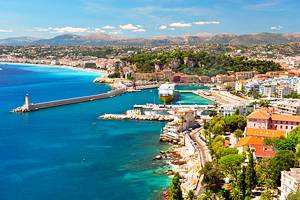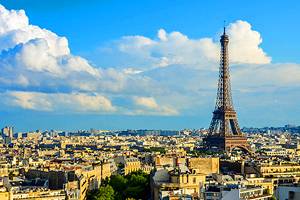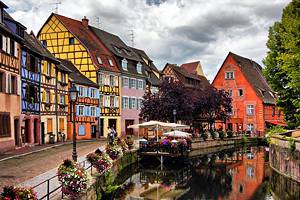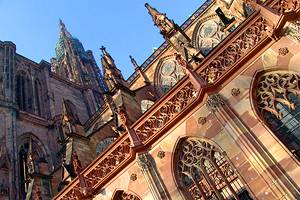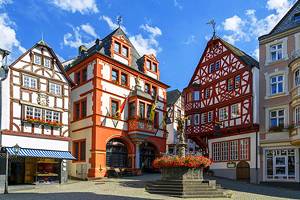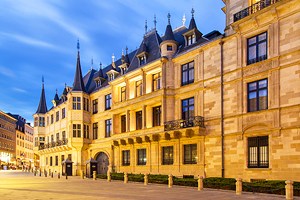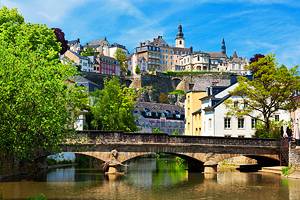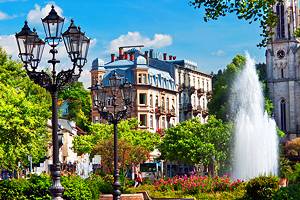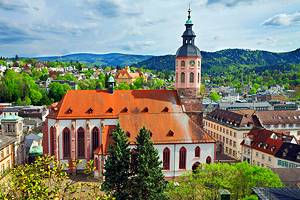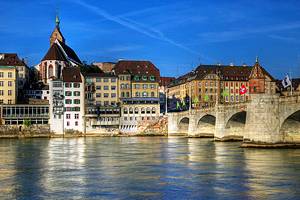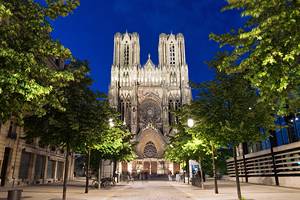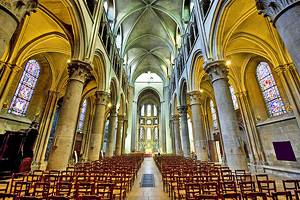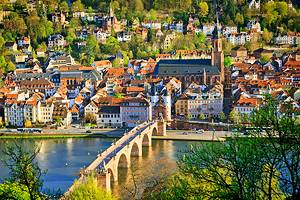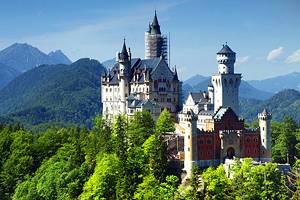Attractions & Things to Do in Nancy
Unusual for a French city, the "new" section of town draws the most attention in Nancy. The relatively young, but very refined Ville Neuve (New Town) has only clocked four centuries of history. Compare that to the city's Ville Vieille (Old Town), which dates back to the 11th century.

The Duke of Lorraine (known as "Charles the Great") developed the Ville Neuve in the late 16th century, using a "modern" grid plan. Stanislas Leszczyńska, father-in-law of Louis XV, added to the Ville Neuve by creating a central public square lined with magnificent Baroque palaces.
Today, the assortment of monuments on the Place Stanislas are classified as a UNESCO World Heritage Site, along with two other public squares: the Place Carrière and the Place d'Alliance. These three squares exemplify the harmonious architecture and well-designed urban planning of the Enlightenment period.
Although the Ville Neuve gets all the glory in Nancy, don't skip over the Ville Vieille (Old Town). This medieval quarter is a trendy neighborhood full of historic landmarks and brimming with boutiques, restaurants, and outdoor cafés.
Nancy is also renowned for Art Nouveau architecture and art. You will find beautiful examples of Art Nouveau buildings in between Place André Maginot and Place Stanislas, as well as a museum dedicated to the Art Nouveau movement.
Discover the best places to visit with our list of the top attractions and things to do in Nancy.
- Place Stanislas
- Palais des Ducs de Lorraine (Musée Lorrain)
- Musée des Beaux-Arts de Nancy
- Musée de l'Ecole de Nancy
- Ville Vieille (Old Town)
- Eglise des Cordeliers
- Place de la Carrière and Place d'Alliance
- Basilique Saint-Epvre
- Parc de la Pépinière
- Eglise Notre-Dame de Bonsecours
- Map of Attractions & Things to Do in Nancy
Place Stanislas

If you only have time to see one tourist attraction in Nancy, then you must visit the Place Stanislas. This unmissable historic landmark, at the heart of Nancy's Ville Neuve, is designated as a UNESCO World Heritage Site.
Originally called the Place Royale, the Place Stanislas was mainly designed by architect Emmanuel Héré between 1752 and 1760. The pedestrian-only square is encircled by five elegant palaces featuring Neoclassical facades with opulent balconies and balustrades.
The largest of the palaces is the Hôtel de Ville (Town Hall), with banisters by Jean Lamour on the staircase. This expansive monument takes up the entire south side of the Place Stanislas.
The gilded railings at the ends of the streets and around the Fountains of Neptune and Amphitrite are also the work of Lamour. The fountains were created by Barthélemy Guibal.
Along the north side of the square are graceful single-story galleried buildings, which continue along Rue Héré. Many restaurants are found here, as well as on the nearby Rue des Maréchaux.
Because of its central location and lively ambience, the area around the Place Stanislas is a great place to stay while visiting Nancy.
Palais des Ducs de Lorraine (Musée Lorrain)

Just steps away from the Place Stanislas in the Ville Vieille is the former Palais des Ducs de Lorraine (Ducal Palace). This grandiose 15th-century palace exemplifies the richly decorated Flamboyant style with its ornate balconies and doorway.
The Ducal Palace now houses the Musée Lorrain (Lorraine Museum), which contains art, antiquities, and historic objects from the Lorraine region. The museum also displays exhibits within the adjacent Eglise des Cordeliers, a former Franciscan church.
The Lorraine Museum is currently undergoing renovations. The Eglise des Cordeliers will remain open (year-round, Tuesday through Sunday) during the renovation project, presenting an exhibit titled Nancy, Capitale des Ducs de Lorraine (Nancy, Capital of the Dukes of Lorraine).
Address: Palais des Ducs de Lorraine, 64 Grande Rue, Nancy
Musée des Beaux-Arts de Nancy

The Musée des Beaux-Arts de Nancy presents a superb collection of European paintings from the 14th to the 21st centuries. The museum has an exceptional European Painting collection, with masterpieces by Caravaggio, Jean Honoré Fragonard, Eugène Delacroix, Pietro Perugino, and Peter Paul Rubens.
The museum was created in 1793 during the French Revolution, when the church property of France was confiscated. Therefore artworks seized from France's churches formed the museum's early collection.
Unique to this museum is the assortment of paintings by Lorraine artists: Claude Gellée ("Le Lorrain"), Émile Friant, Etienne Cournault, Jules Bastien-Lepage, and Victor Prouvé.
For a totally different perspective, the Modern Art assortment includes avant-garde works by Bonnard, Matisse, Modigliani, and Picasso among others.
The Sculpture collection includes noteworthy pieces by Auguste Rodin, Domenico Guidi, César Baldaccini, Raymond Duchamp-Villon, and other 20th-century masters.
One of the highlights of this museum is the Daum collection of Art Nouveau and Art Deco glassworks. These decorative crystal pieces are appreciated for their delicate aesthetic quality and historical value.
Museum hours are 10am until 6pm, Wednesday through Monday, year-round. The museum is closed on Tuesdays and on national holidays (January 1st, May 1st, July 14th, November 1st, and December 25th).
Address: 3 Place Stanislas, Nancy
Musée de l'Ecole de Nancy

The Musée de l'Ecole de Nancy showcases the works of artists who established the local Art Nouveau movement. This art movement flourished in Nancy from the late 19th century until the early 20th century.
The museum occupies the Villa Majorelle, a gem of Art Nouveau architecture built in the early 1900s for the artist Louis Majorelle. The Villa Majorelle was later owned by Eugène Corbin, an important collector of Ecole de Nancy artworks.
Spend some time admiring the collections, which cover a range of categories: ceramics, glass, furniture, objects d'art, textiles, and jewelry. You'll be dazzled by the assortment of stained-glass windows, the most emblematic of Art Nouveau artworks. Other highlights include the assortment of lamps, creatively designed in the shape of flowers, mushrooms, and even an onion.
The museum has a romantic garden that features colorful flowerbeds and lush vegetation. The garden also includes three Art Nouveau pieces that are listed as Monuments Historiques: a funerary monument, a pavilion that contains an aquarium, and the decorative oak door of the Ateliers Gallé.
Address: 36-38 Rue du Sergent Blandan, Nancy
Ville Vieille (Old Town)

The quaint Ville Vieille of Nancy is found north of the Ville Neuve, roughly bordered by the town's three main traffic arteries: Rue Saint-Dizier, Rue Saint-Georges, and Rue Saint-Jean.
The labyrinth of narrow, winding cobblestone streets gives the Ville Vieille a special old-world character, which distinguishes it from the orderly 18th-century Ville Neuve quarter. This medieval and Renaissance quarter is an enchanting place to explore at leisure. Wandering the pedestrian lanes leads to discoveries of stately old buildings, intimate squares, and small courtyards.
On the Rue Saint-Georges, the city's 18th-century Cathédrale Notre-Dame de l'Annonciation has a domed interior decorated in ornate Baroque style. Claude Jacquart, a renowned artist from Nancy, painted the magnificent fresco on the dome's cupola.
At the end of the Rue Saint-Georges is the Porte Saint-Georges. Classified as a Monument Historique, this impressive Renaissance-era city gate was built between 1606 and 1619, when Nancy's Ville Neuve was being developed. The gate depicts an equestrian statue of Saint George (the town's patron saint) slaying a dragon.
The charm and bustling ambience of the Ville Vieille make it a favorite area for locals to live. It's also a spot where city dwellers like to dine out, socialize, and shop at the flea markets. This atmospheric quarter is packed with boutiques, restaurants, and outdoor cafés.
Locals and tourists alike appreciate the Marché de la Ville Vieille, a traditional open-air market that brings together dozens of local vendors selling specialty foods. The market is held near the Palais des Ducs de Lorraine on Sundays from 8am to 1pm.
Eglise des Cordeliers

In the Ville Vieille just beyond the Palais des Ducs de Lorraine is the 15th-century Eglise des Cordeliers. It takes its name from the Franciscan Order, which required monks to wear a cord around the waist.
Created for Duke René II after the Battle of Nancy, the church contains the tombs of the ducal house of Lorraine including Duke René II, his wife Philippa of Guelders, and the Cardinal de Vaudémont. There are also tombs of famous kings of France.
The Dukes of the Baroque period are buried in the 17th-century Chapelle Ducale, which is considered a gem of Renaissance architecture. This delicate circular-shaped chapel was inspired by the Medici Chapel in Florence.
The Eglise des Cordeliers (open year-round, Tuesday through Sunday) is currently presenting an exhibit in collaboration with the Musée Lorrain. The exhibit focuses on the history of the Dukes of Lorraine.
Address: 66 Grande Rue, Nancy
Place de la Carrière and Place d'Alliance

Along with the Place Stanislas, both the Place de la Carrière and Place d'Alliance are designated as a UNESCO World Heritage Site. These public squares epitomize the elegance and refinement that distinguishes Nancy.
The Arc de Triomphe (triumphal arch) in honor of Louis XV leads into the Place de la Carrière, which is enclosed at the other end by the Palais du Gouvernement. The Place de la Carrière was created in the 16th century as a square for jousting tournaments and equestrian games.

The Place d'Alliance is a small fountain-adorned square within easy walking distance of the Place de la Carrière. With its meticulously manicured central garden, the Place d'Alliance resembles the Place des Vosges, one of the most beautiful squares in Paris.
The Place de la Carrière and the Place d'Alliance provide passersby with an oasis of calm in the heart of the city. Both squares have a harmonious feel, thanks to the uniformity of architectural style and the tidy rows of perfectly trimmed trees.
Basilique Saint-Epvre

Within the medieval Ville Vieille is a surprising 19th-century monument, the Basilique Saint-Epvre. This Gothic Revival church is filled with riches endowed by Napoleon III, Pope Pius, Emperor Franz-Joseph of Austria, and King Ludwig II of Bavaria.
Precious treasures of the church include exquisite stained-glass windows and paving in the choir made of stones that came from the Appian Way (the ancient Roman road). Artists from several European countries contributed to the church's collection of paintings.
The church, with its soaring 87-meter-high tower, stands on one of the busiest squares in Nancy, the Place Saint-Epvre. After visiting the Basilique Saint-Epvre, take a moment to admire the square's majestic statue of Duke Rene II.
Address: Place Saint-Epvre, Nancy
Parc de la Pépinière

The Parc de la Pépinière was created on the site of the historic Dukes' gardens and has strong ties to the city's heritage. This park is the largest green space in the city.
The park is just a few steps away from Nancy's UNESCO-listed squares, the Place Stanislas and the Place de la Carrière. Nearby is the Grande Rue, a pedestrian street lined with trendy boutiques and gourmet restaurants.
English-style landscaping distinguishes the Parc de la Pépinière, with its spacious lawns, rose garden, and tree-lined walking paths. You should visit this park to relax on a sunny day, take a leisurely stroll, or simply admire the flowers and birds.
When the weather is nice, plan to have a picnic here. You can easily enjoy a baguette, cheese, and fresh fruit while lounging on the grass or on a park bench.
If you prefer a hearty sit-down meal, try the Brasserie de la Pépinière. This casual eatery features outdoor seating on garden terraces. For a sweet treat, head to the park's Gaufres et Glaces kiosk for ice cream and waffles.
The park also has several things to do for children: a playground, the "Espace Animalier" (mini zoo), the Mini Golf course, and the Théâtre de Marionnettes (Marionette Theater).
Eglise Notre-Dame de Bonsecours

Architect Emmanuel Héré designed this jewel box of a church. A masterpiece of Baroque art, the lavish interior contains the tomb of Stanislas Leszczyńska and the mausoleum of his wife Catharina Opalińska.
This church is also called the Church of Our Lady of Victory and the Kings.
Address: 256 Avenue de Strasbourg, Nancy
Map of Attractions & Things to Do in Nancy
More Related Articles on PlanetWare.com
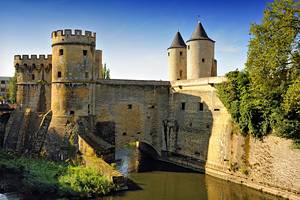
Nearby Places to Visit in the Lorraine Region: The countryside and historic towns of the Lorraine region has many cultural attractions. The city of Metz (55 kilometers away) boasts a breathtaking cathedral, dazzling opera house, superb art museums, and ancient churches. Just outside of Nancy (24 kilometers away) is the medieval town of Toul and a splendid 18th-century château in Lunéville (37 kilometers away).
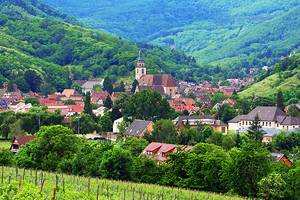
Charming Alsatian Villages and Historic Towns: The neighboring region of Alsace is a lovely rural landscape sandwiched between the Vosges Mountains and the Rhine River plain, dotted with storybook Alsatian villages and historic towns. The charming town of Colmar (about a two-hour drive from Nancy) delights visitors with flower-bedecked half-timbered houses, a scenic canal area, and fascinating old churches.
For those who appreciate culture, Strasbourg is a must-see destination that's only one hour and 30 minutes away from Nancy by the rapid TGV train. As the Alsace region's most important city, Strasbourg has an awe-inspiring cathedral, top-notch museums, and captivating neighborhoods full of old-world ambience.
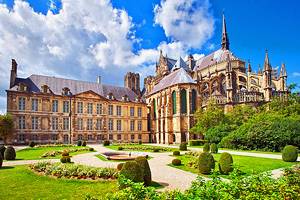
Other Beautiful Regions near Nancy: Lorraine borders the Champagne region, an idyllic countryside of vine-covered rolling hills. The Champagne region has an incredible wealth of historic monuments, such as the marvelous Gothic cathedral in the medieval city of Reims (about two hours and 45 minutes away by train or car) along with several other UNESCO-listed World Heritage Sites.
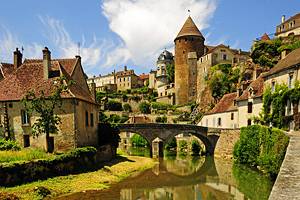
Exploring the Burgundy Region: To the south of Nancy, the Burgundy region beckons visitors with serene pastoral scenery, pristine woodlands, picturesque villages, and interesting historic monuments. The cultural attractions of Dijon (about a two-hour-and 30-minute drive or TGV train ride from Nancy) make it an obligatory stop in Burgundy. Tourists will enjoy visiting the town's ducal palace, gothic churches, and fine arts museum, as well as savoring the delicious regional cuisine.



